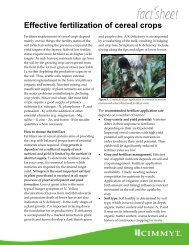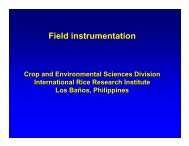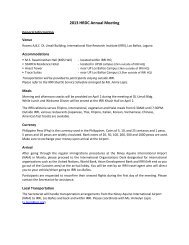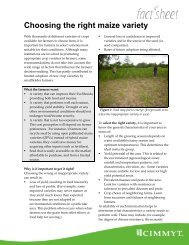Water management in irrigated rice - Rice Knowledge Bank ...
Water management in irrigated rice - Rice Knowledge Bank ...
Water management in irrigated rice - Rice Knowledge Bank ...
- No tags were found...
You also want an ePaper? Increase the reach of your titles
YUMPU automatically turns print PDFs into web optimized ePapers that Google loves.
the ma<strong>in</strong> system is supply-driven, farmers havecontrol over the tim<strong>in</strong>g and amount of water at thefarm gate because water is stored <strong>in</strong> small farmponds, which can also provide water for other uses(Mushtaq et al 2006).5.2 Field versus irrigation system levelThe relationships between water use at the fieldand at the irrigation system level are complex and<strong>in</strong>volve hydrological, <strong>in</strong>frastructural, and economicaspects. At the field level, farmers can reduce waterlosses by adopt<strong>in</strong>g water-sav<strong>in</strong>g technologies(Chapter 3). If they pay for the cost of the waterthey use, they can thereby <strong>in</strong>crease the profitabilityof <strong>rice</strong> farm<strong>in</strong>g. At the irrigation system level, theadoption of field-level water-sav<strong>in</strong>g technologieswill reduce the total amount of water lost as evaporation,but by relatively small amounts only. Mostof the water saved at the field level is by reducedseepage, percolation, and dra<strong>in</strong>age flows. On theone hand, this results <strong>in</strong> more water reta<strong>in</strong>ed at thesurface (<strong>in</strong> the irrigation canals), which is availablefor downstream farmers. On the other hand,it reduces the amount of water re-enter<strong>in</strong>g the hydrologicalcycle and thus reduces the options for<strong>in</strong>formal reuse downstream. Reduc<strong>in</strong>g percolationfrom <strong>rice</strong> fields can lower groundwater tables. Thiscan adversely affect yields s<strong>in</strong>ce <strong>rice</strong> plants may beless able to extract water directly from the groundwater(Chapter 1.4; Belder et al 2004). Deepergroundwater tables will also <strong>in</strong>crease the cost ofpump<strong>in</strong>g for reuse downstream. Any adoption ofwater-sav<strong>in</strong>g technologies requires considerablewater control by the farmers. This is not much ofa problem for farmers us<strong>in</strong>g their own pump, butit is so for farmers <strong>in</strong> large-scale surface irrigationsystems that lack flexibility <strong>in</strong>, and reliability of,water delivery. It is also a problem for farmers us<strong>in</strong>gelectricity to pump groundwater where supplies areunreliable, as <strong>in</strong> northwest India. To allow farmersto profit from water-sav<strong>in</strong>g technologies, suchirrigation systems need to be modernized, whichcomes at an economic cost.The “beneficiaries” of water sav<strong>in</strong>gs at thefield and irrigation system level are different <strong>in</strong> mostcases. At the irrigation system level, the irrigationsystem <strong>management</strong> can save water <strong>in</strong> agricultureand use this water for other purposes such as hydropowergeneration or <strong>in</strong>dustry. Farmers will be<strong>in</strong>terested <strong>in</strong> sav<strong>in</strong>g water only if they can derivebenefits such as reduced irrigation costs. A detaileddiscussion of motives to save water is presented <strong>in</strong>Chapter 1.7.5.3 Integrated approachesApproaches that <strong>in</strong>tegrate agronomic measures,improved policies, <strong>in</strong>stitutional reforms, and <strong>in</strong>frastructuralupgrad<strong>in</strong>gs may have the best chance ofsuccessfully respond<strong>in</strong>g to water scarcity. A recentsuccess story is the Zanghe Irrigation System (ZIS)<strong>in</strong> the middle reaches of the Yangtze Bas<strong>in</strong> <strong>in</strong> Ch<strong>in</strong>a(Loeve et al 2004a,b). ZIS has a command area ofabout 160,000 ha and services ma<strong>in</strong>ly <strong>rice</strong> <strong>in</strong> thesummer season. S<strong>in</strong>ce the early 1970s, the amountof water released to agriculture has been steadilyreduced <strong>in</strong> favor of <strong>in</strong>creased releases to cities,<strong>in</strong>dustry, and hydropower (Fig. 5.4). S<strong>in</strong>ce the mid-1990s, the amount of water received by agriculturehas been less than 30% of the amount received <strong>in</strong>the early 1970s. In the same period, however, total<strong>rice</strong> production has <strong>in</strong>creased, with a productionpeak of around 650,000 tons <strong>in</strong> the late eighties thatwas nearly twice the amount produced <strong>in</strong> the latesixties. Although <strong>rice</strong> production has leveled off toa stable 500,000 tons <strong>in</strong> the last decade, more <strong>rice</strong>has been produced with less water over the past 30years. This feat has been accomplished by a varietyof <strong>in</strong>tegrated measures (Dong et al 2004, Hong etal 2001, Loeve et al 2001, 2004a,b, Mushtaq et al2006, Moya et al 2004): Double <strong>rice</strong> cropp<strong>in</strong>g has been replaced bymore water-efficient s<strong>in</strong>gle <strong>rice</strong> cropp<strong>in</strong>g.This was possible because of the availabilityof modern short-duration high-yield<strong>in</strong>g varieties. The alternate wett<strong>in</strong>g-dry<strong>in</strong>g water-sav<strong>in</strong>gtechnology has been promoted and widelyadopted. Policies, such as volumetric water pric<strong>in</strong>g,and <strong>in</strong>stitutional reforms, such as water-userassociations, have been <strong>in</strong>troduced that driveand promote efficient use of water by farmers. The irrigation system has been upgraded (e.g.,canal l<strong>in</strong><strong>in</strong>g). Secondary storage has been developedthrough the creation of thousands of small- tolarge-size ponds and reservoirs.The ZIS case study suggests that w<strong>in</strong>-w<strong>in</strong>situations can exist where <strong>rice</strong> production can be41


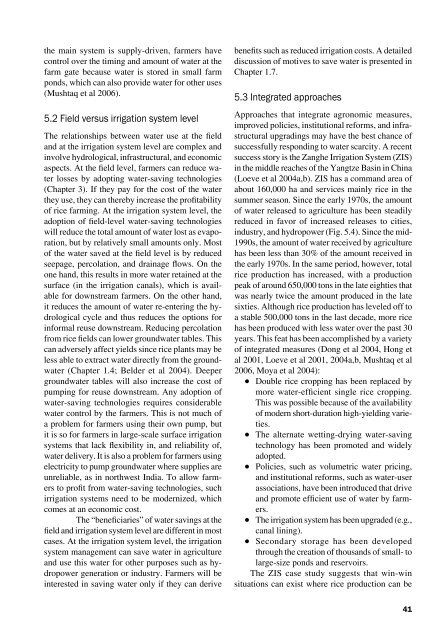


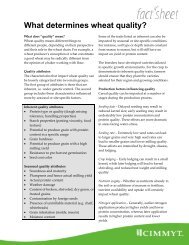

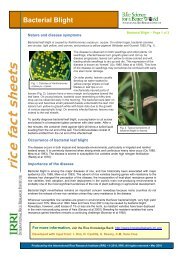

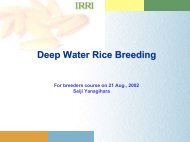
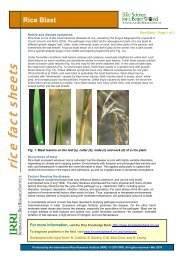
![International Standards' Organization â Rice Specification [ISO 7301]](https://img.yumpu.com/36696862/1/190x245/international-standards-organization-a-rice-specification-iso-7301.jpg?quality=85)

